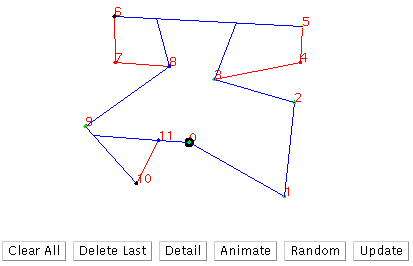Visibility polygon
Enter vertices of a SIMPLE polygon in counter-clockwise (CCW) order.
After clicking Update, the visibility polygon of vertex 0 is shown in blue.
I made some modifications to the linear time algorithm of ElGindy and
Avis, "A linear algorithm for computing the visibility polygon from a
point", J. Algorithms 2, 1981, p. 186--197. I use only one stack
instead of three, store only original vertices to maintain tight
control of numerical complexity, handle degenerate inputs, and
correctly handle spirals of more than 360 degrees. These may be
similar to Joe's corrections to Lee's algorithm (B. Joe and
R. B. Simpson, "Correction to {Lee}'s visibility polygon algorithm",
BIT, 27, 1987, p. 458--473.), but I don't have access to BIT at the
moment to check.
To emphasize that the data structure uses only original polygon
vertices (for numerical robustness), the display may look non-simple.
To interpret the output at right, the circled p0 is the orgin, green (0,1,2,3,9)
and blue (8,11) vertices are visible endpoints of visible edges, with
blue indicating that the previous edge is not visible. Yellow (5) and
black (6,10) are invisible endpoints of visible edges.
|
 |
Known bugs: The polygon is not checked for simplicity or
orientation, so entering a non-simple, or CW oriented polygon will
cause strange results and error messages on the Java console. (I
think I catch all possible infinite loops.)
- Detail toggles the vertex numbers and some of the edge weights.
- Animate toggles the behavior of Update: Either the visibility
polygon for vertex 0 is computed, or visibility polygons for each vertex are
computed and displayed for two seconds.
- Update is the button you push when the input is ready
- Clear All and Delete Last give minimalist editing.
The visibility polygon is used in computing a
minimum convex decomposition.
